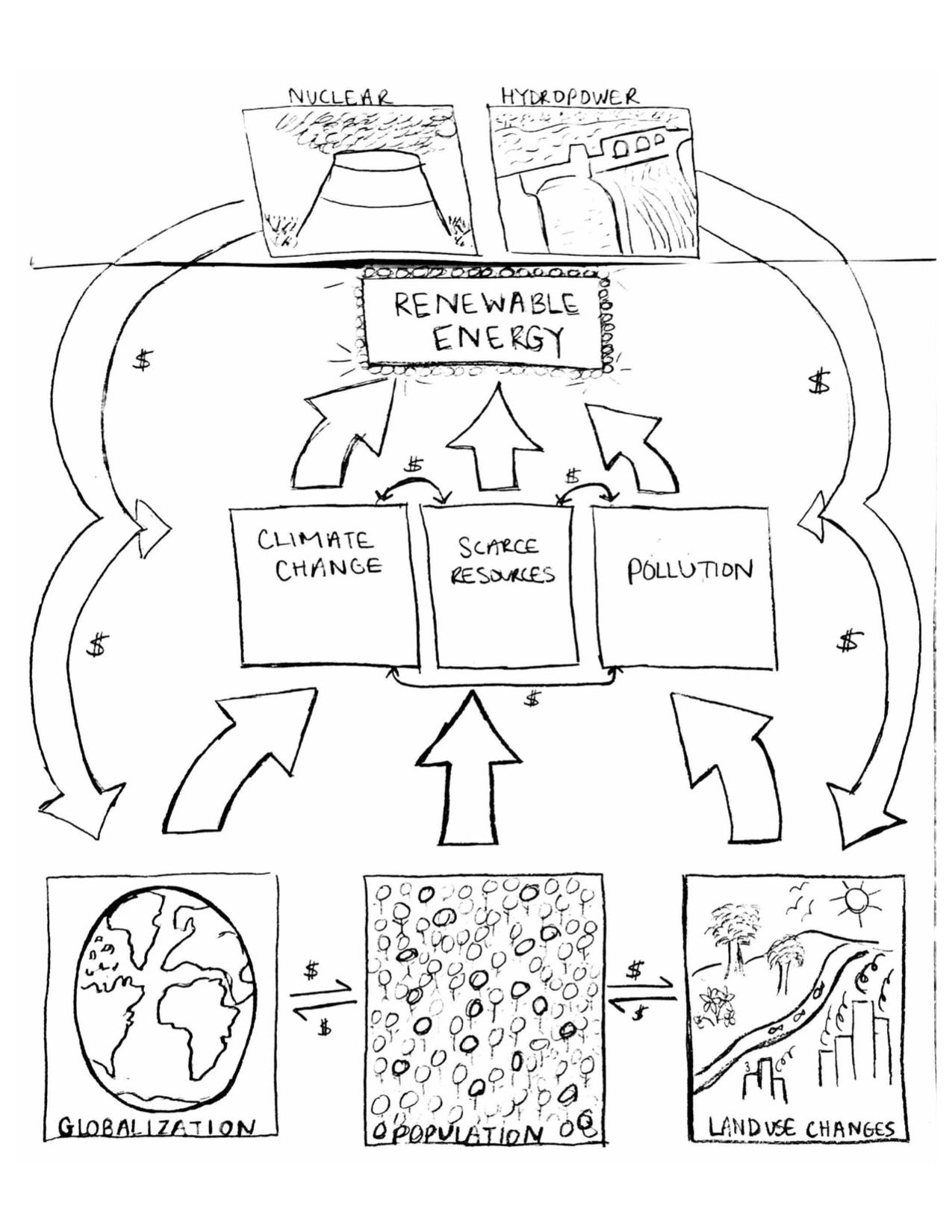Direct and Indirect Environmental Consequences
In this flow chart, we see that there are both indirect and direct environmental consequences that have effected China and Beijing’s society. Globalization, overpopulation, and land use changes have driven climate change, resource scarcity, and pollution, which in turn has drastically necessitated a need to transition to renewable energy infrastructures.

| Indirect Environmental Consequences |
- Globalization is the shrinkage of time and space due to the introduction and spread of technologies and an increase in the flow of goods, capital people and ideas (Shapiro, 2016). The desire to be a known, active, and respectable machine on a global scale has lead to the vitality of China’s economic status. When comparing Mao’s time to today, we see that China has gone from being an isolationist country to the manufacturing center of the world (Shapiro, 2016).

Industrial activity and the production of goods for the global market involves the emittance of high levels of pollution. The value of China’s exports in 2013 made it the #1 exporter in the world, and 94% of these exports were manufactured goods (Shapiro, 2016). A majority of this manufacturing has gone on in China’s cities, especially its capital, Beijing. In Beijing, the air index quality can get up to about 220 — a “very unhealthy level” – making the air extremely polluted and unsafe for people (Dong, 2015).

- Overpopulation is another indirect source of environmental damage. With a greater population comes more pressure on land and resources and increased pollution. Beijing has a population of 23,000,000.
- Changes of land usage was a result of rapid industrialization. Pressure on the land became more intense, and increasing amounts of resources were extracted for means of production. As manufacturing increased, the jobs and wages such manufacturing provided increased the appeal of working and living in cities as well. The exploitation of farmland further drove peasants to pick up and move to cities. Overall, around a third of Beijing residents have migrated to the city for its appeal. An increasing population only increases environmental pressures however, as more people means more mouths to feed and more resources to extract, including water. Industry continues to develop and more cars are driven, which leads to even more pollution in the air.
| Direct Environmental Consequences |
- Climate change is one of the biggest environmental issues of our generation. China’s contribution to climate change is growing due to its immense amount of carbon emissions. The economy’s reliance on coal supplies and the intense international competition to secure access to fossil fuels is why it has been so difficult for Beijing’s efforts to stop climate change to take effect (Shapiro, 2016). Higher rates of emissions have lead to severe smog within the city, which has increased illness and disease within the population drastically. Heat waves and other extreme weather conditions have been associated with increased death risk in Beijing (Haidong, 2011).

- Air pollution issues were particularly highlighted during the 2008 Olympic games in Beijing. Life expectancies are shorter, lung diseases occur more often, and smog is so bad people in Beijing can often not even drive (Shapiro, 2016). However, wealthy, government officials didn’t even glance at the issue until 2013, when they knew the whole world would be visiting and watching Beijing during the Olympic games. This demonstrates the existing power dynamic and how simple it is for elites to turn their head at problems invading the lives of millions of people when these people have no power or international influence.

- Water supplies are heavily effected by pollution and extraction, as agricultural practices have been limited and an estimated 300 million people lack access to drinking water (Shapiro, 2016). Among the five major river systems, the North Canal, which is used for 90 percent of the drainage in downtown Beijing and provides water to 70 percent of the population of that city, was the most seriously polluted. A standard test for determining water quality, Chemical Oxygen Demand (COD), confirmed that pollutants in the water of North Canal were nearly 95 times higher than what is deemed safe (Martinot, 2010). The 2012 Beijing Environmental Bulletin, which was issued by the Beijing Municipal Bureau of Environmental Protection, shows that among the 88 rivers monitored by Beijing, 42.1 percent of the total volume of all 88 rivers were classified as the poorest water quality currently designated (Li, 2014).
__________________________________
Reference List:
Dong, Q., & Futawatari, T. (2015). A Study for Renewable Energy Generation and Sustainable Development in China. International Journal of Environmental Science and Development, 6(3), 191-195. doi:http://dx.doi.org/10.7763/IJESD.2015.V6.588
Hsu, C., & Baptiste, A. (2016, October 12). Environmental Historical Context. Lecture presented in Colgate University, Hamilton.
Li, H., Guo, S., Cui, L., Yan, J., Liu, J., & Wang, B. (2015). Review of renewable energy industry in Beijing: Development status, obstacles and proposals. Renewable & Sustainable Energy Reviews, 43711-725. doi:10.1016/j.rser.2014.11.074
Martinot, E. (2010). Renewable Power for China: Past, Present, and Future. Frontiers of Energy and Power Engineering in China, 4(3), 287-294. doi:http://dx.doi.org/10.1007/ s11708-010-0120-z
Shapiro, J. (2016). China’s Environmental Challenges.
Images:
